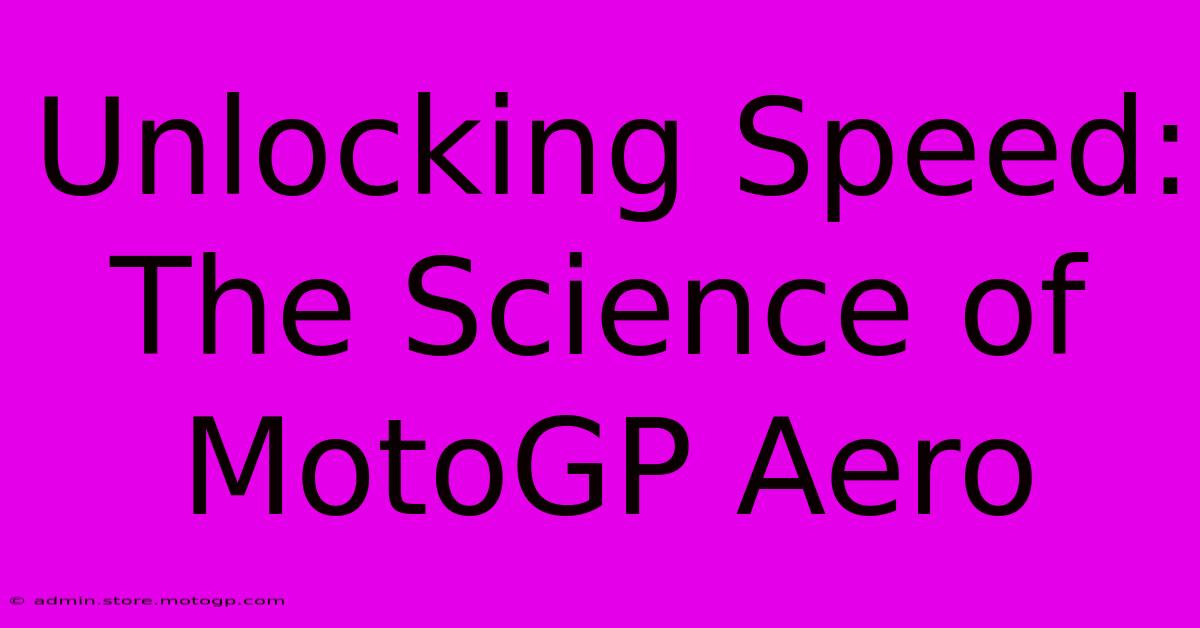Unlocking Speed: The Science Of MotoGP Aero

Table of Contents
Unlocking Speed: The Science of MotoGP Aero
MotoGP, the pinnacle of motorcycle racing, is a relentless pursuit of speed. Every tenth of a second counts, and increasingly, aerodynamic performance is playing a crucial role in separating the champions from the also-rans. This article delves into the fascinating science behind MotoGP aerodynamics, exploring how these intricate designs translate to breathtaking speeds and aggressive racing lines.
The Physics of Speed: Drag Reduction and Downforce
At the heart of MotoGP aero lies a fundamental battle against two opposing forces: drag and downforce. Drag is the resistance an object experiences as it moves through the air; reducing drag is paramount to achieving higher top speeds. Downforce, conversely, is the force pushing the motorcycle towards the track, increasing grip and allowing for faster cornering speeds.
Drag Reduction Techniques:
- Streamlining: MotoGP bikes aren't designed for beauty; they're sculpted for efficiency. Every curve, every angle, is meticulously designed to minimize air resistance. This includes fairing design, which creates a smooth flow of air around the bike, minimizing turbulence and drag.
- Winglets and Aerodynamic Appendages: These small, wing-like structures generate downforce while minimizing drag, a complex engineering feat. Their placement and angle are crucial, with subtle changes affecting performance significantly.
- Fairing Shape and Airflow Management: The shape of the fairing, particularly the nose and tail sections, directly impacts airflow. Advanced Computational Fluid Dynamics (CFD) simulations are used to optimize these shapes, minimizing separation and maximizing airflow efficiency.
Downforce Generation:
- Wings and Aerofoils: Larger wings and aerofoils, often positioned on the front and sides of the bike, generate substantial downforce. These are highly sophisticated designs, often incorporating complex geometries to maximize efficiency.
- Underbody Aerodynamics: The airflow under the bike is also carefully managed. Underbody components can be used to channel airflow effectively, increasing downforce and reducing drag.
The Evolution of MotoGP Aero: From Simple to Sophisticated
MotoGP aerodynamics have evolved dramatically over the years. Early bikes relied primarily on streamlining, while modern machines incorporate complex aerodynamic devices and actively managed airflow. The introduction of winglets and other advanced components has led to a significant increase in cornering speeds and overall performance.
The Role of CFD and Wind Tunnels:
Modern MotoGP aero design relies heavily on advanced computational tools. Computational Fluid Dynamics (CFD) simulations allow engineers to test and refine designs virtually, saving time and resources. Wind tunnel testing is still crucial, providing real-world data to validate and fine-tune simulations.
The Strategic Impact of Aerodynamics:
The impact of aerodynamics extends beyond just raw speed. Effective aero packages can:
- Improve Stability: Increased downforce leads to greater stability at high speeds and through corners, enhancing rider confidence and control.
- Enable Later Braking: Greater downforce allows riders to brake later into corners, gaining crucial time advantages.
- Enhance Cornering Speed: By increasing grip, aerodynamic designs enable riders to carry higher speeds through corners, significantly affecting lap times.
The Future of MotoGP Aero: Continuous Innovation
The pursuit of aerodynamic advantage in MotoGP is ongoing. Expect to see continued innovation in the design of wings, winglets, and other aerodynamic devices. The quest for that marginal gain continues to push the boundaries of what's possible, and the future promises even more breathtaking displays of speed and technological prowess.
Keywords: MotoGP, Aerodynamics, Aero, Downforce, Drag, Winglets, CFD, Wind Tunnel, Motorcycle Racing, Speed, Cornering, Racing Technology, Fairing, Aerofoils, MotoGP Technology, Motorcycle Aerodynamics, Racing Science

Thank you for visiting our website wich cover about Unlocking Speed: The Science Of MotoGP Aero. We hope the information provided has been useful to you. Feel free to contact us if you have any questions or need further assistance. See you next time and dont miss to bookmark.
Featured Posts
-
Austin Gp Sprint Race A Must See Motorsport Event
Feb 18, 2025
-
Austin F1 Transportation Options For Out Of Towners
Feb 18, 2025
-
F1 Austin 2025 Ignite Your Passion
Feb 18, 2025
-
Moto Gps Most Beautiful Tracks Scenic Wonders
Feb 18, 2025
-
Cota One Day Pass Your Key To Columbus Discovery
Feb 18, 2025
